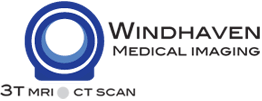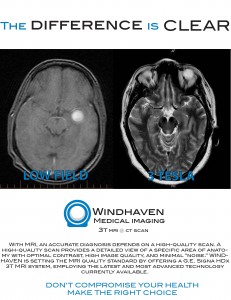Magnetic Resonance Imaging
With MRI, an accurate diagnosis depends on a high-quality scan. A high-quality scan provides a detailed view of a specific area of
anatomy with optimal contrast, high image quality, and minimal “noise.” At Windhaven Medical Imaging, our GE Signa HDx 3T MRI system has twice the field strength of a conventional magnet, allowing for faster patient exams and unparalleled high-definition MRIs. Our state-of-the-art system offers a better signal-to-noise ratio (SNR) and better image resolution.
Applications of 3T MRI at Windhaven include:
- Neurologic Imaging
- Musculoskeletal Imaging
- CT Brain & Renal Angiography (CTA)
- Thoracic and Abdominal Imaging
- Lung Scans for Tumors and Pulmonary Nodule
Download more information about the 3T MRI: GE_HD_3.0T
Compare 3T MRI Brain and 3T MRI Spine images to a low-field MRI
What are some common uses of the procedure?
MR imaging of the body is performed to evaluate:
- organs of the chest and abdomen—including the heart, liver, biliary tract, kidneys, spleen, bowel, pancreas and adrenal glands.
- pelvic organs including the reproductive organs in the male (prostate and testicles) and the female (uterus, cervix and ovaries).
- blood vessels (MR Angiography).
Physicians use the MR examination to help diagnose or monitor treatment for conditions such as:
- tumors of the chest, abdomen or pelvis.
- certain types of heart problems.
- blockages or enlargements of blood vessels, including the aorta, renal arteries, and arteries in the legs.
- diseases of the liver, such as cirrhosis, and that of other abdominal organs, including the bile ducts, gallbladder, and pancreatic ducts.
- diseases of the small intestine, colon, and rectum
- cysts and solid tumors in the kidneys and other parts of the urinary tract.
- tumors and other abnormalities of the reproductive organs (e.g., uterus, ovaries, testicles, prostate).
- causes of pelvic pain in women, such as fibroids, endometriosis and adenomyosis.
- suspected uterine congenital abnormalities in women undergoing evaluation for infertility.
How should I prepare for the procedure?
You may be asked to wear a gown during the exam or you may be allowed to wear your own clothing if it is loose-fitting and has no metal fasteners.
Guidelines about eating and drinking before an MRI exam vary with the specific exam and also with the facility. For some types of exams, you may be asked to fast for 8-12 hours. Unless you are told otherwise, you may follow your regular daily routine and take medications as usual.
Some MRI examinations may require the patient to swallow contrast material or receive an injection of contrast into the bloodstream. The radiologist or technologist may ask if you have allergies of any kind, such as allergy to iodine or x-ray contrast material, drugs, food, the environment, or asthma. However, the contrast material used for an MRI exam, called gadolinium, does not contain iodine and is less likely to cause side effects or an allergic reaction.

MRI
The radiologist should also know if you have any serious health problems or if you have recently had surgery. Some conditions, such as severe kidney disease may prevent you from being given contrast material for an MRI. If there is a history of kidney disease, it may be necessary to perform a blood test to determine whether the kidneys are functioning adequately.
Women should always inform their physician or technologist if there is any possibility that they are pregnant. MRI has been used for scanning patients since the 1980′s with no reports of any ill effects on pregnant women or their babies. However, because the baby will be in a strong magnetic field, pregnant women should not have this exam unless the potential benefit from the MRI is assumed to outweigh the potential risks. See the Safety page (www.RadiologyInfo.org/en/safety/) for more information about pregnancy and MR imaging.
Jewelry and other accessories should be left at home if possible, or removed prior to the MRI scan. Because they can interfere with the magnetic field of the MRI unit, metal and electronic objects are not allowed in the exam room. These items include:
- jewelry, watches, credit cards and hearing aids, all of which can be damaged.
- pins, hairpins, metal zippers and similar metallic items, which can distort MRI images.
- removable dental work.
- pens, pocketknives and eyeglasses.
- body piercings.
In most cases, an MRI exam is safe for patients with metal implants, except for a few types. People with the following implants cannot be scanned and should not enter the MRI scanning area unless explicitly instructed to do so by a radiologist or technologist who is aware of the presence of any of the following:
- internal (implanted) defibrillator or pacemaker
- cochlear (ear) implant
- some types of clips used on brain aneurysms
You should tell the technologist if you have medical or electronic devices in your body, because they may interfere with the exam or potentially pose a risk, depending on their nature and the strength of the MRI magnet. Examples include but are not limited to:
- artificial heart valves
- implanted drug infusion ports
- implanted electronic device, including a cardiac pacemaker
- artificial limbs or metallic joint prostheses
- implanted nerve stimulators
- metal pins, screws, plates, stents or surgical staples
In general, metal objects used in orthopedic surgery pose no risk during MRI. However, a recently placed artificial joint may require the use of another imaging procedure. If there is any question of their presence, an x-ray may be taken to detect the presence of and identify any metal objects.
Young children can sometimes require sedation to complete an MR exam without moving. Moderate and conscious sedation is provided at Windhaven imaging. A qualified medical provider administers sedation to children and is available during the exam to ensure your child’s safety while under the effects of sedation. You will be given special instructions how to prepare your child for the sedation.
How is the procedure performed?
You will be positioned on the moveable examination table. Straps and bolsters may be used to help you stay still and maintain the correct position during imaging.
Small devices that contain coils capable of sending and receiving radio waves may be placed around or adjacent to the area of the body being studied.
If a contrast material will be used in the MRI exam, a technologist will insert an intravenous (IV) line into a vein in your hand or arm. A saline solution may be used. The solution will drip through the IV to prevent blockage of the IV line until the contrast material is injected.
You will be moved into the magnet of the MRI unit and the technologist will leave the room while the MRI examination is performed.
If a contrast material is used during the examination, it will be injected into the intravenous line (IV) after an initial series of scans. Additional series of images will be taken during or following the injection.
When the examination is completed, you may be asked to wait until the technologist checks the images in case additional images are needed.
MRI exams generally include multiple runs (sequences), some of which may last several minutes.
Depending on the type of exam and the equipment used, the entire exam is usually completed in 15 to 45 minutes.
What will I experience during and after the procedure?
Most MRI exams are painless, however, some patients find it uncomfortable to remain still during MR imaging. Others experience a sense of being closed-in (claustrophobia). Therefore, sedation can be arranged for those patients who anticipate anxiety, but fewer than one in 20 require it.
It is normal for the area of your body being imaged to feel slightly warm, but if it bothers you, notify the radiologist or technologist. It is important that you remain perfectly still while the images are being recorded, which is typically only a few seconds to a few minutes at a time. For some types of exams, you may be asked to hold your breath. You will know when images are being recorded because you will hear tapping or thumping sounds when the coils that generate the radiofrequency pulses are activated. You will be able to relax between imaging sequences, but will be asked to maintain your position as much as possible.
You will usually be alone in the exam room during the MRI procedure. However, the technologist will be able to see, hear and speak with you at all times using a two-way intercom. Many MRI centers allow a friend or parent to stay in the room as long as they are also screened for safety in the magnetic environment.
You may be offered or you may request earplugs to reduce the noise of the MRI scanner, which produces loud thumping and humming noises during imaging. Children will be given appropriately sized earplugs or headphones during the exam. MRI scanners are air-conditioned and well-lit. Some scanners have music to help you pass the time.
When the contrast material is injected, it is normal to feel coolness and a flushing sensation for a minute or two. The intravenous needle may cause you some discomfort when it is inserted and once it is removed, you may experience some bruising. There is also a very small chance of irritation of your skin at the site of the IV tube insertion.
If you have not been sedated, no recovery period is necessary. You may resume your usual activities and normal diet immediately after the exam. A few patients experience side effects from the contrast material, including nausea and local pain. Very rarely, patients are allergic to the contrast material and experience hives, itchy eyes or other reactions. If you experience allergic symptoms, a radiologist or other physician will be available for immediate assistance.
Who interprets the results and how do I get them?
Our fellowship trained radiologists will interpret your radiology examinations, analyze the images and send a signed report to your referring physician, who will share the results with you.
What are the benefits?
MRI is a noninvasive imaging technique that does not involve exposure to ionizing radiation.
MR images of the soft-tissue structures of the body—such as the heart, liver and many other organs— is more likely in some instances to identify and accurately characterize diseases than other imaging methods. This detail makes MRI an invaluable tool in early diagnosis and evaluation of many focal lesions and tumors.
MRI has proven valuable in diagnosing a broad range of conditions, including cancer, heart and vascular disease, and muscular and bone abnormalities.
MRI enables the discovery of abnormalities that might be obscured by bone with other imaging methods.
MRI allows physicians to assess the biliary system non-invasively and without contrast injection.
The contrast material used in MRI exams is less likely to produce an allergic reaction than the iodine-based contrast materials used for conventional x-rays and CT scanning.
MRI provides a noninvasive alternative to x-ray, angiography and CT for diagnosing problems of the heart and blood vessels.




